How Land-Take Impacts the Provision of Ecosystem Services—The Case of the Province of Monza and Brianza (Italy)
Abstract
1. Introduction
2. Materials and Methods
2.1. Preliminary Step
2.2. Phase 1: Definition of the ESs Provided by NUAs
2.3. Phase 2: Choice of the Reference Periods
2.4. Phase 3: Creation of the NUAs Map
2.5. Phase 4: Choice of the Layers to Be Used for Indexes Calculation
2.6. Step 2: Indexes Calculation for Each Reference Period
2.7. Phase 5: Assessment of Provisioning ESs and Calculation of the I_Prov_Agr Index
| Land Use Class | SAgr | I_Prov_Agr |
|---|---|---|
| Vineyards and orchards | 125 | 1.00 |
| Horticulture, floriculture, and plant nurseries in greenhouses | 110 | 0.88 |
| Crops, vegetable gardens, meadows, horticulture, floriculture, and plant nurseries (not in greenhouses). | 100 | 0.80 |
| Farms and agricultural production settlements | 90 | 0.72 |
| Poplars | 25 | 0.20 |
2.8. Phase 6: Assessment of Regulating ESs and Calculation of the I_Reg_Nat Index
| Layer | Typology | Score |
|---|---|---|
| Protected area and local park | Natura 2000 sites | 1.00 |
| Priority areas of intervention | 1.00 | |
| Natural parks | 0.75 | |
| Regional parks | 0.50 | |
| Local parks | 0.25 | |
| Regional ecological network | Primary elements | 0.50 |
| Secondary elements | 0.25 | |
| Priority areas for biodiversity | Priority areas for biodiversity | 0.50 |
| Provincial ecological network | Primary corridors | 0.25 |
| Secondary corridors | 0.15 |
| Naturalistic Value of Soils | Land Use/Land Cover | ||
|---|---|---|---|
| Class | Score | Class | Score |
| High * | 1.1 | Natural | 1.0 |
| Medium | 1.0 | Agricultural | 0.9 |
| Low | 1.0 | Urban | 0.0 |
2.9. Phase 7: Assessment of Cultural ESs and Calculation of the I_Cult_Land Index
| Landscape Restrictions (Land_Res) * | Historical and Scenic Trails (Sc_Trails) | Landscape Elements from Provincial Plans (LEPP) | Land Use/Land Cover (LULC) | ||||
|---|---|---|---|---|---|---|---|
| Class | Score | Class | Score | Class | Score | Class | Score |
| yes | 1.0 | yes | 1.0 | Historical gardens | 1.0 | Woods | 0.8 |
| no | 0.0 | no | 0.0 | Monumental trees | 1.0 | Vineyards | 0.6 |
| Geosites | 1.0 | Riparian woods | 0.4 | ||||
| Areas of landscape significance | 0.8 | Wetland vegetation | 0.4 | ||||
| Rural settlements of landscape significance (50 m buffer) | 0.6 | Bush with trees | 0.4 | ||||
2.10. Phase 8: Calculation of Composite Index
2.11. Step 3: ESs Evolution
2.12. Phase 9: Analysis of Indexes Dynamics
3. Results and Discussion
3.1. Land-Take and NUAs Evolution
3.2. Evolution of the Provisioning ESs Coming from Agriculture (I_Prov_Agr Index)
3.3. Evolution of the Regulating ESs Provided by Natural Resources (I_Reg_Nat Index)
3.4. Evolution of the Cultural ESs Provided by Landscape (I_Cult_Land Index)
3.5. Evolution of the Overall ESs Provided by Non-Urbanized Areas (CQI* Index)
4. Conclusions
Author Contributions
Funding
Data Availability Statement
Acknowledgments
Conflicts of Interest
References
- Weber, T.; Sloan, A.; Wolf, J. Maryland’s green infrastructure assessment: Development of a comprehensive approach to land conservation. Landsc. Urban Plan. 2006, 77, 94–110. [Google Scholar] [CrossRef]
- Tzoulas, K.; Korpela, K.; Venn, S.; Yli-Pelkonen, V.; Kaźmierczak, A.; Niemela, J.; James, P. Promoting ecosystem and human health in urban areas using green infrastructure: A literature review. Landsc. Urban Plan. 2007, 81, 167–178. [Google Scholar] [CrossRef]
- La Rosa, D.; Privitera, R. Characterization of non-urbanized areas for land-use planning of agricultural and green infrastructure in urban contexts. Landsc. Urban Plan. 2013, 109, 94–106. [Google Scholar] [CrossRef]
- European Union. Building a Green Infrastructure for Europe; European Union Publications Office: Bruxelles, Belgium, 2014; Available online: https://op.europa.eu/en/publication-detail/-/publication/738d80bb-7d10-47bc-b131-ba8110e7c2d6/language-en (accessed on 5 March 2025).
- Fairbrass, A.; Jones, K.; McIntosh, A.; Yao, Z.; Malki-Epshtein, L.; Bell, S. Green Infrastructure for London: A Review of the Evidence. A Report by the Engineering Exchange for just Space and the London Sustainability Exchange. 2018. Available online: https://www.ucl.ac.uk/engineering-exchange/sites/engineering-exchange/files/ucl-green-infrastructure-for-london.pdf (accessed on 5 March 2025).
- Millennium Ecosystem Assessment. Ecosystems and Human Well-Being: Synthesis; Island Press: Washington, DC, USA, 2005; Available online: https://www.millenniumassessment.org/documents/document.356.aspx.pdf (accessed on 5 March 2025).
- Colsaet, A.; Laurans, Y.; Levrel, H. What drives land take and urban land expansion? A systematic review. Land Use Policy 2018, 79, 339–349. [Google Scholar] [CrossRef]
- Arcidiacono, A.; Di Simine, D.; Ronchi, S.; Salata, S. Consumo di Suolo, Servizi Ecosistemici e Green Infrastructures: Caratteri Territoriali, Approcci Disciplinari e Progetti Innovativi; Rapporto 2018; INU Edizioni: Rome, Italy, 2018; Available online: https://hdl.handle.net/11311/1199996 (accessed on 5 March 2025).
- SNPA (Sistema Nazionale per la Protezione dell’Ambiente). Consumo di Suolo, Dinamiche Territoriali e Servizi Ecosistemici. Edizione 2024. Report Ambientali SNPA 2024, 43/2004. Available online: https://www.snpambiente.it/temi/suolo/consumo-di-suolo-dinamiche-territoriali-e-servizi-ecosistemici-edizione-2024/ (accessed on 5 March 2025).
- Lombardy Region. Legge Regionale 28 Novembre 2014, n. 31. Disposizioni per la Riduzione del Consumo di Suolo e per la riqualificazione del Suolo Degradato; BURL n. 49, suppl. del 1 Dicembre 2014. Available online: https://normelombardia.consiglio.regione.lombardia.it/NormeLombardia/Accessibile/main.aspx?iddoc=lr002014112800031&view=showdoc#n9 (accessed on 5 March 2025).
- Senes, G.; Fumagalli, N.; Ferrario, P.S.; Rovelli, R.; Sigon, R. Definition of a land quality index to preserve the best territories from future land take. An application to a study area in Lombardy (Italy). J. Agric. Eng. 2020, 51, 43–55. [Google Scholar] [CrossRef]
- Koschke, L.; Furst, C.; Frank, S.; Makeschin, F. A multi-criteria approach for an integrated land-cover-based assessment of ecosystem services provision to support landscape planning. Ecol. Indicat. 2012, 21, 54–66. [Google Scholar] [CrossRef]
- Logsdon, R.A.; Chaubey, I. A quantitative approach to evaluating ecosystem services. Ecol. Model. 2013, 257, 57–65. [Google Scholar] [CrossRef]
- Albert, C.; Galler, C.; Hermes, J.; Neuendorf, F.; von Haaren, C.; Lovett, A. Applying ecosystem services indicators in landscape planning and management: The ES-in-Planning framework. Ecol. Indic. 2016, 61, 100–113. [Google Scholar] [CrossRef]
- De Montis, A.; Serra, V.; Ganciu, A.; Ledda, A. Assessing landscape fragmentation: A composite indicator. Sustainability 2020, 12, 9632. [Google Scholar] [CrossRef]
- Ronchi, S.; Salata, S.; Arcidiacono, A.; Piroli, E.; Montanarella, L. Policy instruments for soil protection among the EU member states: A comparative analysis. Land Use Policy 2019, 82, 763–780. [Google Scholar] [CrossRef]
- Costanza, R.; d’Arge, R.; De Groot, R.; Farber, S.; Grasso, M.; Hannon, B.; Limburg, K.; Naeem, S.; O’neill, R.V.; Paruelo, J. The value of the world’s ecosystem services and natural capital. Nature 1997, 387, 253–260. [Google Scholar] [CrossRef]
- Dai, X.; Johnson, B.A.; Luo, P.; Yang, K.; Dong, L.; Wang, Q.; Liu, C.; Li, N.; Lu, H.; Ma, L.; et al. Estimation of Urban Ecosystem Services Value: A Case Study of Chengdu, Southwestern China. Remote Sens. 2021, 13, 207. [Google Scholar] [CrossRef]
- de Groot, R.; Brander, L.; van der Ploeg, S.; Costanza, R.; Bernard, F.; Braat, L.; Christie, M.; Crossman, N.; Ghermandi, A.; Hein, L.; et al. Global estimates of the value of ecosystems and their services in monetary units. Ecosyst. Serv. 2012, 1, 50–61. [Google Scholar] [CrossRef]
- Hu, Z.; Wang, S.; Bai, X.; Luo, G.; Li, Q.; Wu, L.; Yang, Y.; Tian, S.; Li, C.; Deng, Y. Changes in ecosystem service values in karst areas of China. Agric. Ecosyst. Environ. 2020, 301, 107026. [Google Scholar] [CrossRef]
- Rao, Y.X.; Zhou, M.; Ou, G.L.; Dai, D.Y.; Zhang, L.; Zhang, Z.; Nie, X.; Yang, C. Integrating ecosystem services value for sustainable land-use management in semi-arid region. J. Clean. Prod. 2018, 186, 662–672. [Google Scholar] [CrossRef]
- Xie, G.; Zhang, C.; Zhen, L.; Zhang, L. Dynamic changes in the value of China’s ecosystem services. Ecosyst. Serv. 2017, 26, 146–154. [Google Scholar] [CrossRef]
- Abulizi, A.; Yang, Y.; Mamat, Z.; Luo, J.; Abdulslam, D.; Xu, Z.; Zayiti, A.; Ahat, A.; Halik, W. Land-Use Change and its Effects in Charchan Oasis, Xinjiang, China. Land Degrad. Dev. 2017, 28, 106–115. [Google Scholar] [CrossRef]
- Jiang, W.; Lu, Y.H.; Liu, Y.X.; Gao, W.W. Ecosystem service value of the Qinghai- Tibet Plateau significantly increased during 25 years. Ecosyst. Serv. 2020, 44, 101146. [Google Scholar] [CrossRef]
- Liu, M.; Jia, Y.; Zhao, J.; Shen, Y.; Pei, H.; Zhang, H.; Li, Y. Revegetation projects significantly improved ecosystem service values in the agro-pastoral ecotone of northern China in recent 20 years. Sci. Total Environ. 2021, 788, 147756. [Google Scholar] [CrossRef]
- Ma, S.; Wang, H.Y.; Wang, L.J.; Jiang, J.; Gong, J.W.; Wu, S.; Luo, G.Y. Evaluation and simulation of landscape evolution and its ecological effects under vegetation restoration in the northern sand prevention belt, China. Catena 2022, 218, 106555. [Google Scholar] [CrossRef]
- Cai, Y.; Zhang, P.; Wang, Q.; Wu, Y.; Ding, Y.; Nabi, M.; Fu, C.; Wang, H.; Wang, Q. How does water diversion affect land use change and ecosystem service: A case study of Baiyangdian wetland, China. J. Environ. Manag. 2023, 344, 118558. [Google Scholar] [CrossRef]
- Wang, L.; Luo, G.; Ma, S.; Wang, H.; Jiang, J.; Zhang, J. Integrating landscape ecological risk into ecosystem service value assessment: A case study of Nanjing City, China. Ecol. Indic. 2023, 154, 110625. [Google Scholar] [CrossRef]
- Chen, W.; Zhao, H.; Li, J.; Zhu, L.; Wang, Z.; Zeng, J. Land use transitions and the associated impacts on ecosystem services in the Middle Reaches of the Yangtze River Economic Belt in China based on the geo-informatic Tupu method. Sci. Total Environ. 2020, 701, 134690. [Google Scholar] [CrossRef]
- Li, Z.; Kuang, Y. The Effects of Agricultural land Consolidation on Carbon and Ecosystem Service Value Changes in Jiangxi Province, China. J. Biotech Res. 2023, 14, 95–105. [Google Scholar]
- Das, A.; Das, D.; Houqe, R.; Pereira, P. Mapping ecosystem services for ecological planning and management: A case from a tropical planning region, Eastern India. Environ. Sci. Pollut. Res. 2023, 30, 7543–7560. [Google Scholar] [CrossRef] [PubMed]
- Tiandraza, F.; Qu, S.; Hu, S.; Mkono, C.N.; Tikhomirova, A.; Randrialahamady, S.N. Response of Ecosystem Services to Land Use Change in Madagascar Island, Africa: A Multi-Scale Perspective. Int. J. Environ. Res. Public Health 2023, 20, 3060. [Google Scholar] [CrossRef] [PubMed]
- Ankur, P.; Chatterjee, S.; Gupta, K. Evaluation on the change characteristics of ecosystem service in Dhanbad district of Jharkhand, India based on land use change. GeoJournal 2022, 87, 413–437. [Google Scholar] [CrossRef]
- Chen, R.; Huang, C. Landscape Evolution and It’s Impact of Ecosystem Service Value of the Wuhan City, China. Int. J. Environ. Res. Public Health 2021, 18, 13015. [Google Scholar] [CrossRef]
- Hasan, S.; Shi, W.; Zhu, X. Impact of land use land cover changes on ecosystem service value—A case study of Guangdong, Hong Kong, and Macao in South China. PLoS ONE 2020, 15, e0231259. [Google Scholar] [CrossRef]
- Zhang, J.; Qu, M.; Wang, C.; Zhao, J.; Cao, Y. Quantifying landscape pattern and ecosystem service value changes: A case study at the county level in the Chinese Loess Plateau. Glob. Ecol. Conserv. 2020, 23, e01110. [Google Scholar] [CrossRef]
- Li, S.; Yang, H.; Liu, J.; Lei, G. Towards ecological-economic integrity in the Jing-Jin-Ji regional development in China. Water 2018, 10, 1653. [Google Scholar] [CrossRef]
- Liu, Y.; Li, J.; Zhang, H. An ecosystem service valuation of land use change in Taiyuan City, China. Ecol. Model. 2012, 225, 127–132. [Google Scholar] [CrossRef]
- Erős, T.; Petrovszki, J.; Mórocz, A. Planning for sustainability: Historical data and remote sensing-based analyses aid landscape design in one of the largest remnant European floodplains. Landsc. Urban Plan. 2023, 238, 104837. [Google Scholar] [CrossRef]
- Montoya-Tangarife, C.; De La Barrera, F.; Salazar, A.; Inostroza, L. Monitoring the effects of land cover change on the supply of ecosystem services in an urban region: A study of Santiago-Valparaíso, Chile. PLoS ONE 2017, 12, e0188117. [Google Scholar] [CrossRef] [PubMed]
- Ramirez-Gomez, S.O.I.; Torres-Vitola, C.A.; Schreckenberg, K.; Honzák, M.; Cruz-Garcia, G.S.; Willcock, S.; Palacios, E.; Pérez-Miñana, E.; Verweij, P.A.; Poppy, G.M. Analysis of ecosystem services provision in the Colombian Amazon using participatory research and mapping techniques. Ecosyst. Serv. 2015, 13, 93–107. [Google Scholar] [CrossRef]
- Kopperoinen, L.; Itkonen, P.; Niemelä, J. Using expert knowledge in combining green infrastructure and ecosystem services in land use planning: An insight into a new place-based methodology. Landsc. Ecol. 2014, 29, 1361–1375. [Google Scholar] [CrossRef]
- Frank, S.; Fürst, C.; Witt, A.; Koschke, L.; Makeschin, F. Making use of the ecosystem services concept in regional planning—Trade-offs from reducing water erosion. Landsc. Ecol. 2014, 29, 1377–1391. [Google Scholar] [CrossRef]
- Deng, J.; Lin, Y.; Zhou, M.; Wu, C.; Chen, B.; Xiao, G.; Cai, J. Ecosystem services dynamics response to tremendous reclamation in a coastal island city. Ecosyst. Health Sustain. 2019, 5, 155–168. [Google Scholar] [CrossRef]
- Mengist, W.; Soromessa, T.; Feyisa, G.L. Landscape change effects on habitat quality in a forest biosphere reserve: Implications for the conservation of native habitats. J. Clean. Prod. 2021, 329, 129778. [Google Scholar] [CrossRef]
- Yohannes, H.; Soromessa, T.; Argaw, M.; Dewan, A. Spatio-temporal changes in habitat quality and linkage with landscape characteristics in the Beressa watershed, Blue Nile basin of Ethiopian highlands. J. Environ. Manag. 2021, 281, 111885. [Google Scholar] [CrossRef]
- Jia, K.; Huang, A.; Yin, X.; Yang, J.; Deng, L.; Lin, Z. Investigating the Impact of Urbanization on Water Ecosystem Services in the Dongjiang River Basin: A Spatial Analysis. Remote Sens. 2023, 15, 2265. [Google Scholar] [CrossRef]
- Yohannes, H.; Soromessa, T.; Argaw, M.; Dewan, A. Impact of landscape pattern changes on hydrological ecosystem services in the Beressa watershed of the Blue Nile Basin in Ethiopia. Sci. Total Environ. 2021, 793, 148559. [Google Scholar] [CrossRef]
- Zhong, L.; Wang, J.; Zhang, X.; Ying, L. Effects of agricultural land consolidation on ecosystem services: Trade-offs and synergies. J. Clean. Prod. 2020, 264, 121412. [Google Scholar] [CrossRef]
- González-García, A.; Palomo, I.; González, J.A.; López, C.A.; Montes, C. Quantifying spatial supply-demand mismatches in ecosystem services provides insights for land-use planning. Land Use Policy 2020, 94, 104493. [Google Scholar] [CrossRef]
- Moarrab, Y.; Salehi, E.; Amiri, M.J.; Hovidi, H. Spatial–temporal assessment and modeling of ecological security based on land-use/cover changes (case study: Lavasanat watershed). Int. J. Environ. Sci. Technol. 2022, 19, 3991–4006. [Google Scholar] [CrossRef]
- Lyu, R.; Clarke, K.C.; Zhang, J.; Feng, J.; Jia, X.; Li, J. Dynamics of spatial relationships among ecosystem services and their determinants: Implications for land use system reform in Northwestern China. Land Use Policy 2021, 102, 105231. [Google Scholar] [CrossRef]
- Fumagalli, N.; Senes, G.; Ferrario, P.S.; Corsini, D.; Brenna, L. Assessing Ecosystem Services Provided by Rural and Urban Green Areas at Territorial Scale, The Case of the Local Park GruBrìa (Monza and Milan Provinces, Italy); Lecture Notes in Civil Engineering; Springer Nature: Berlin/Heidelberg, Germany, 2025; Volume 586. [Google Scholar] [CrossRef]
- Senes, G.; Fumagalli, N.; Ferrario, P.S.; Rovelli, R.; Riva, F.; Sacchi, G.; Gamba, P.; Ruffini, G.; Redondi, G. Assessment of the ecosystem services given by rural and urban green areas to preserve high-quality territories from land take: The case of the province of Monza Brianza (Italy). J. Agric. Eng. 2023, 54, 1526. [Google Scholar] [CrossRef]
- Haines-Young, R.; Potschin-Young, M. Revision of the common international classification for ecosystem services (CICES V5.1): A policy brief. One Ecosyst. 2018, 3, e27108. [Google Scholar] [CrossRef]
- ISTAT (Italian National Institute of Statistics). Popolazione Residente per Sesso, età e Stato Civile al 1° Gennaio 2024. Demografia in Cifre. 2024. Available online: https://demo.istat.it/app/?l=it&a=2024&i=POS (accessed on 5 March 2025).
- Saaty, T.L. The Analytic Hierarchy Process; McGraw-Hill: New York, NY, USA, 1980. [Google Scholar] [CrossRef]
- Mazaherylaghab, H. Green infrastructure planning and balanced territorial development: Insights from Milan Rural Metropolis. J. Environ. Manag. 2025, 390, 126300. [Google Scholar] [CrossRef]


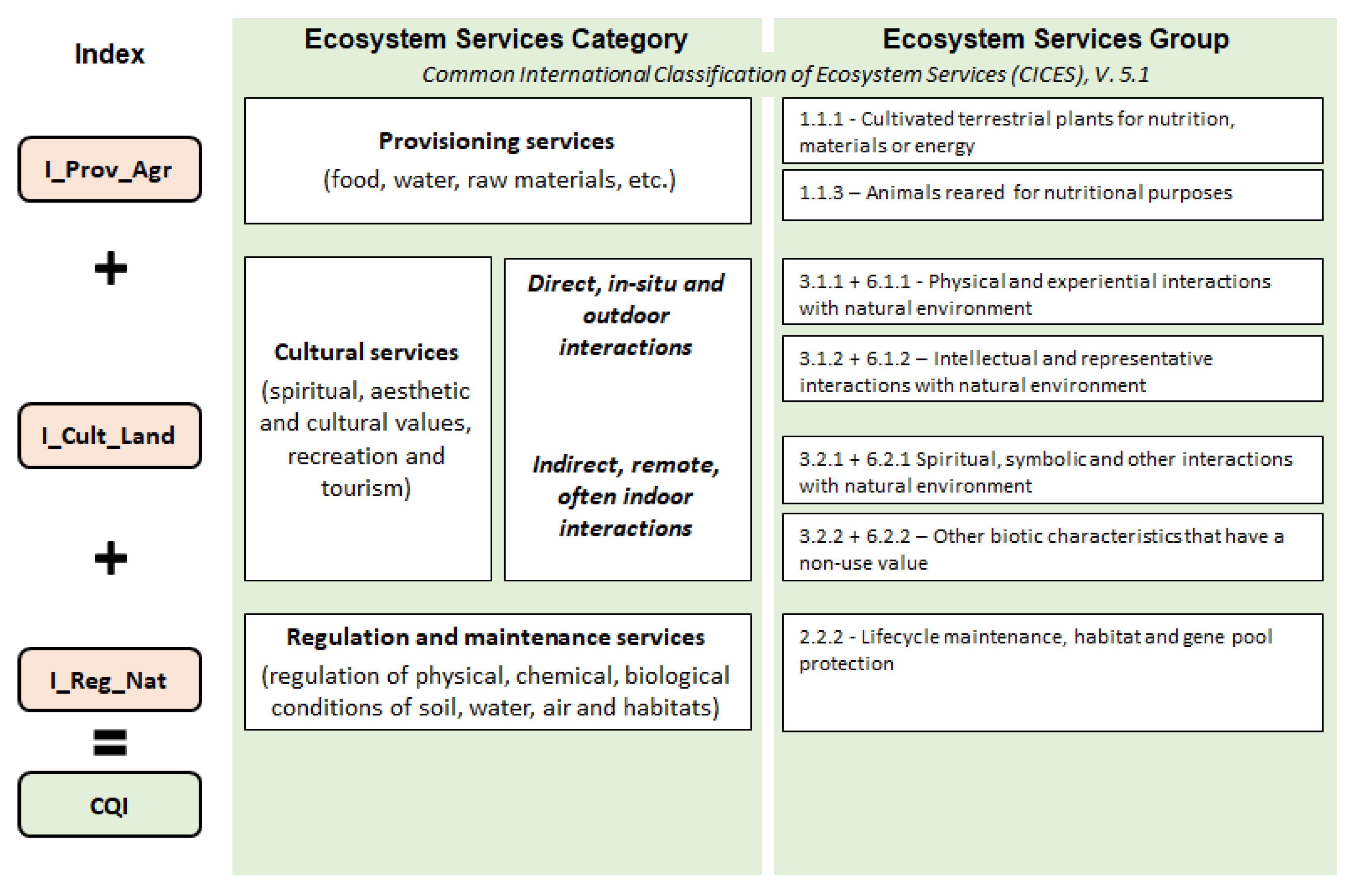

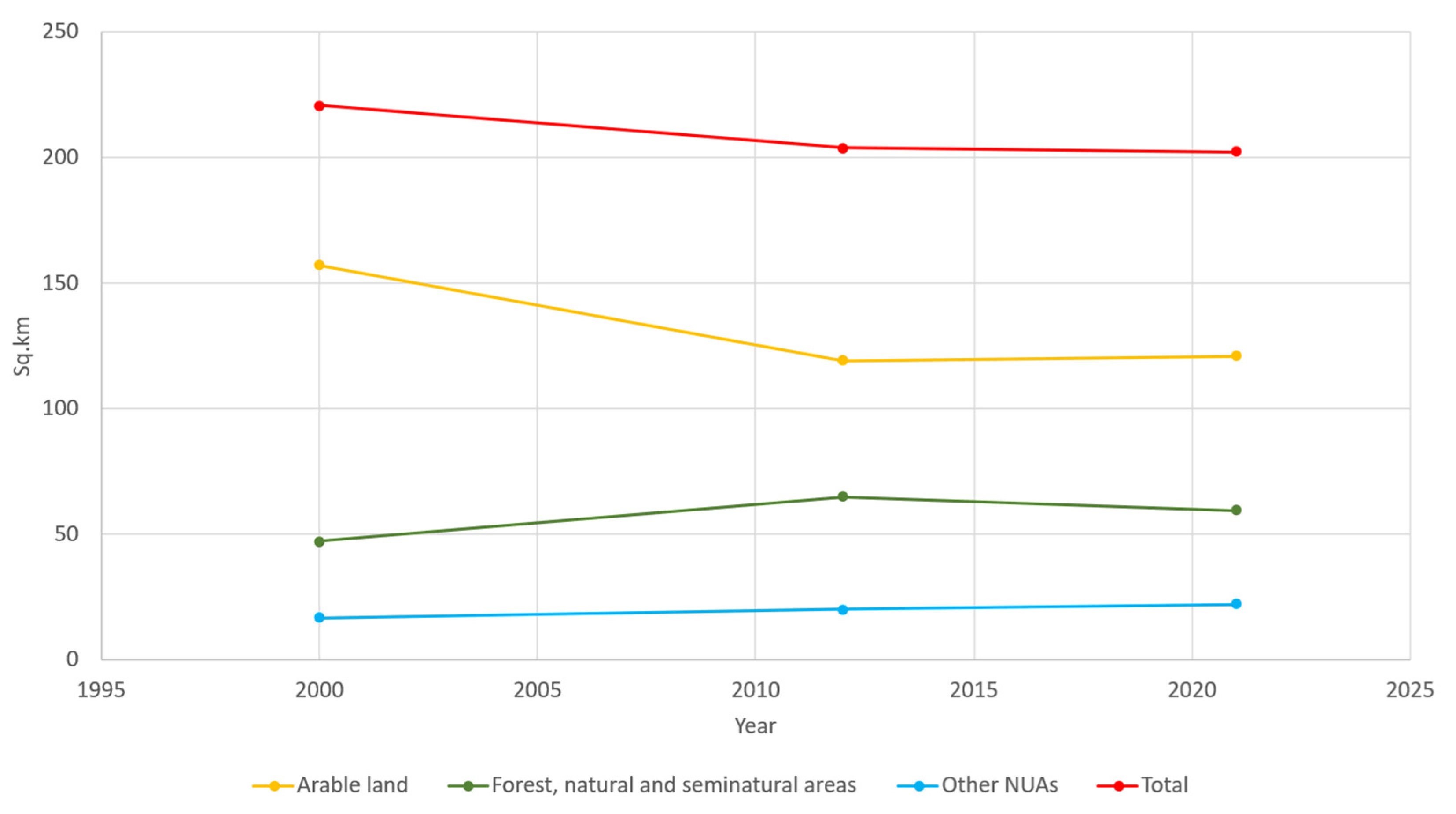

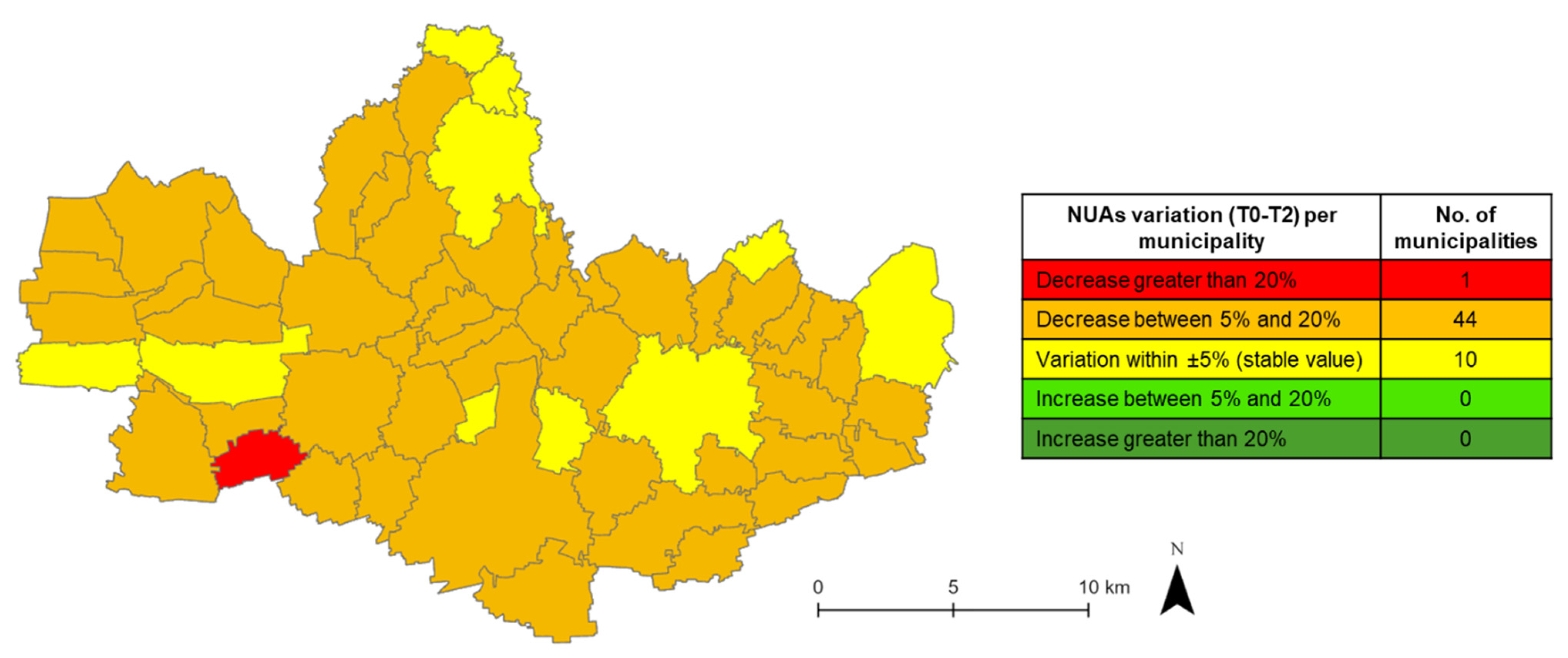
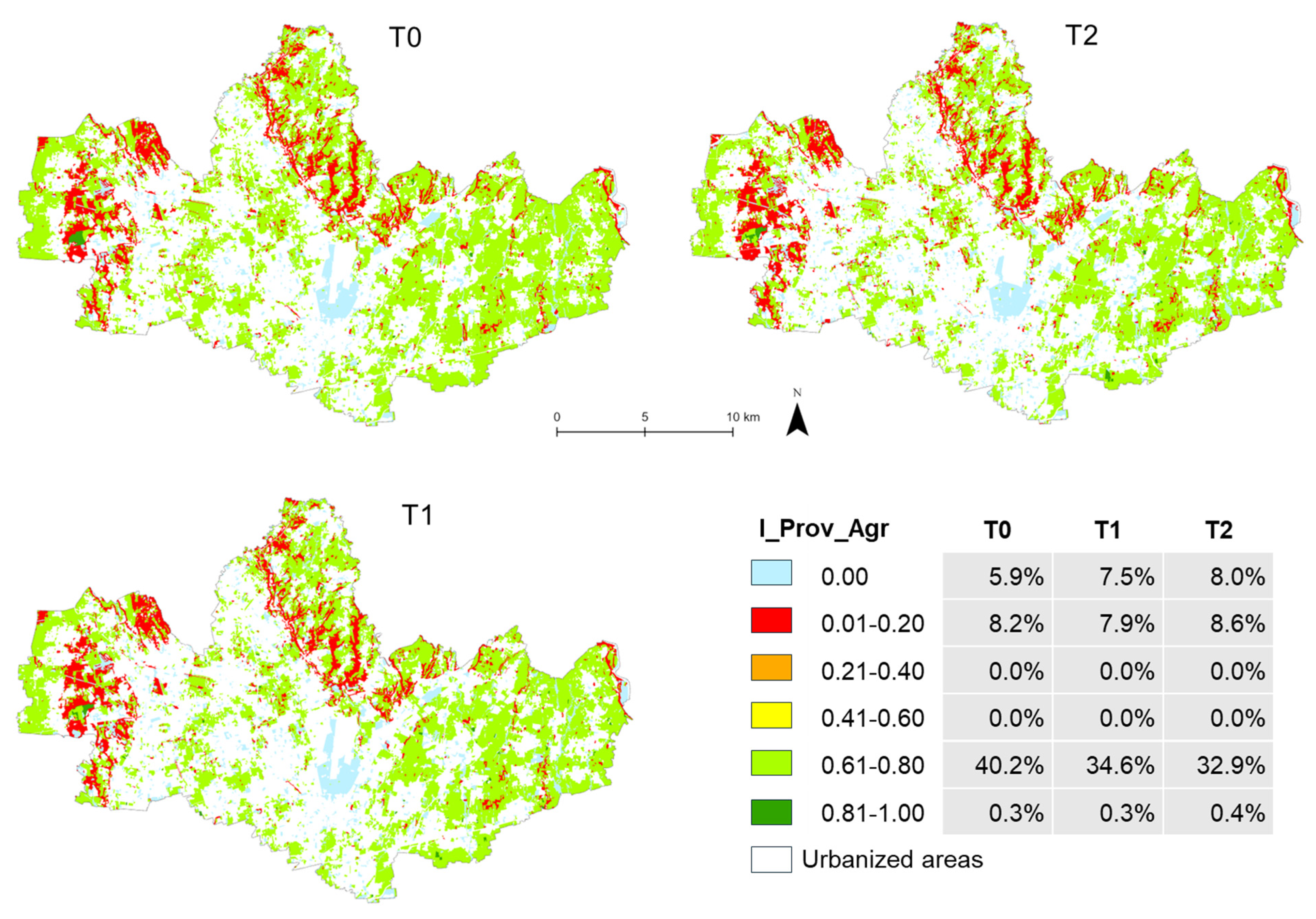

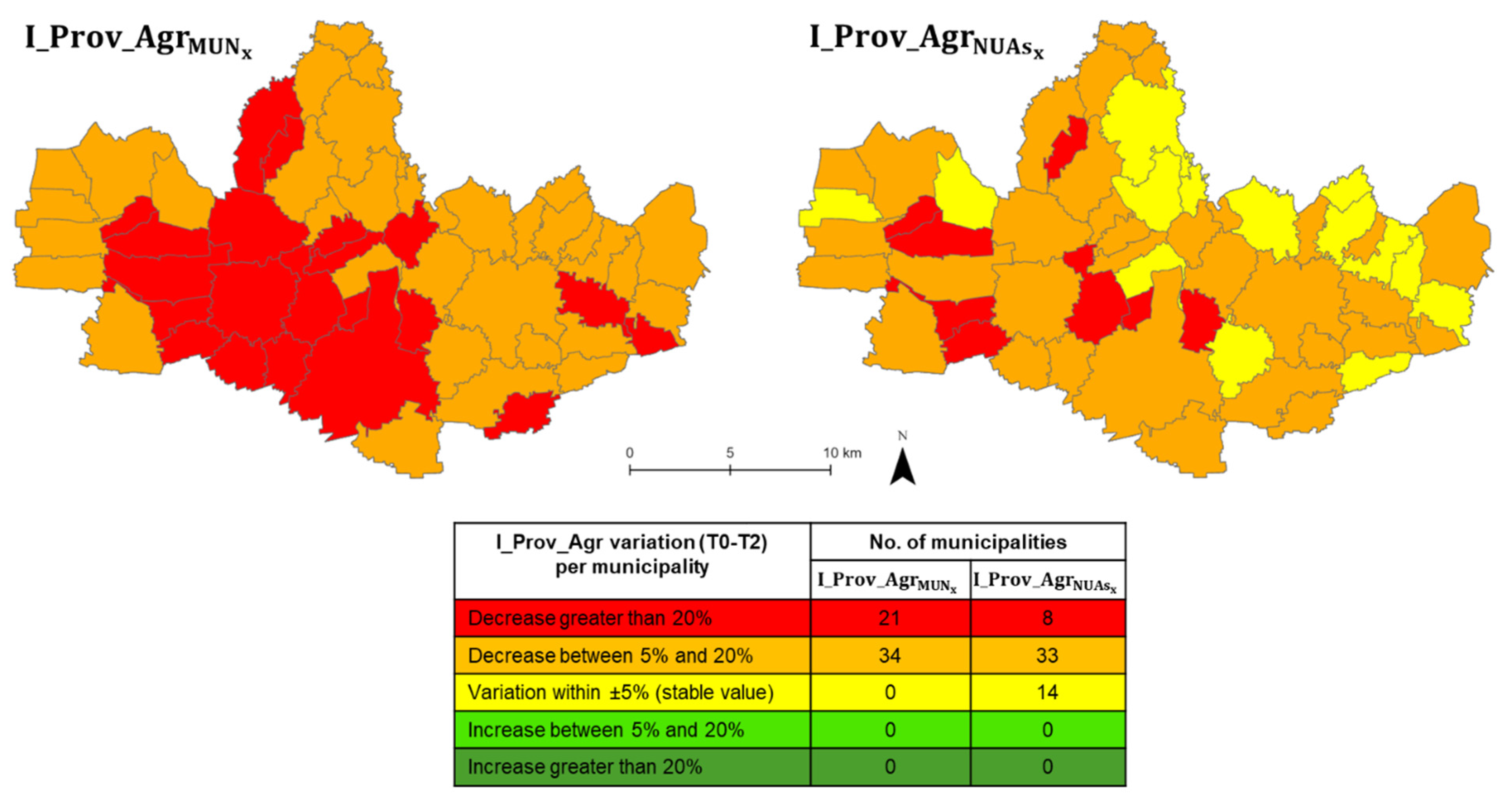
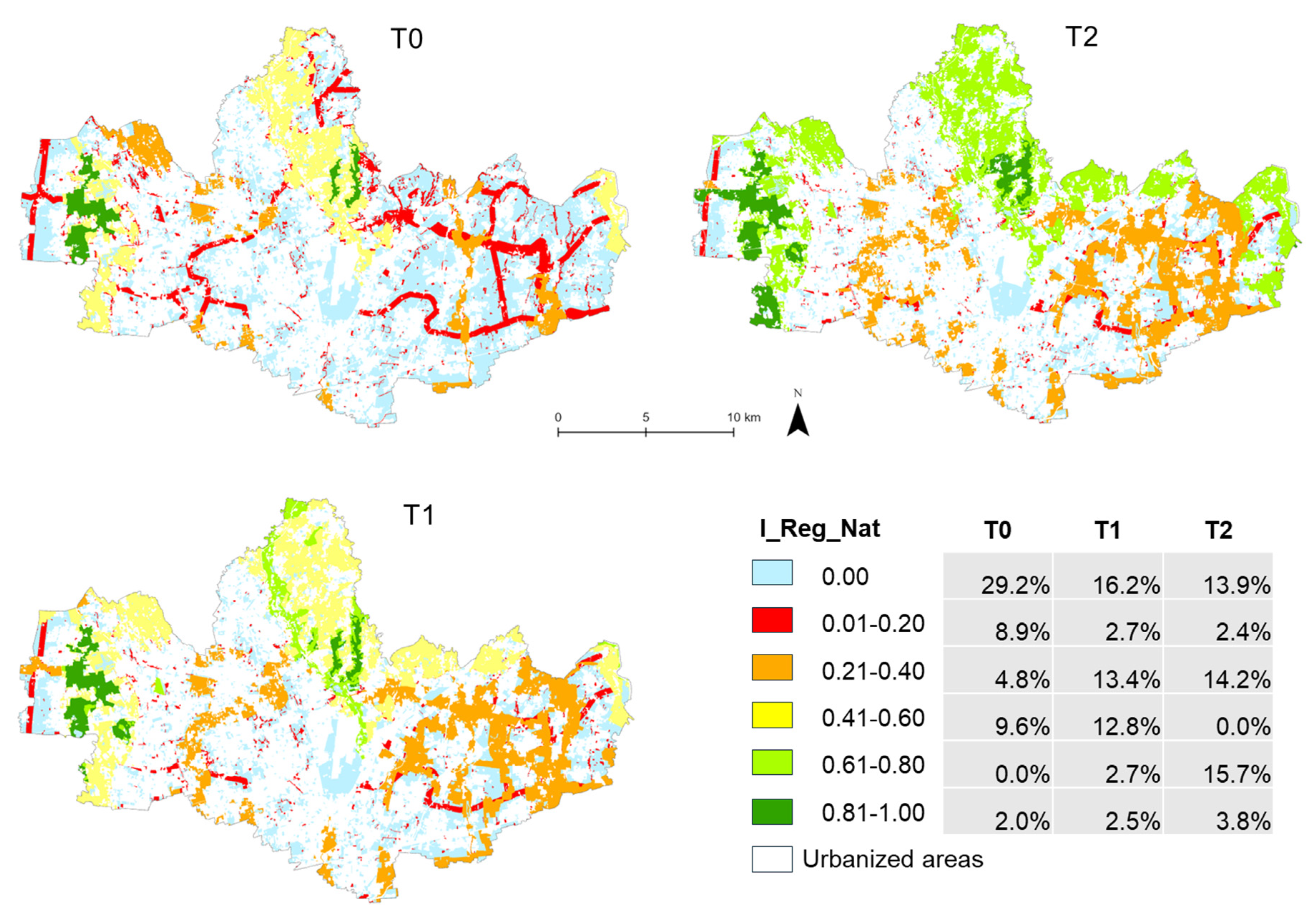
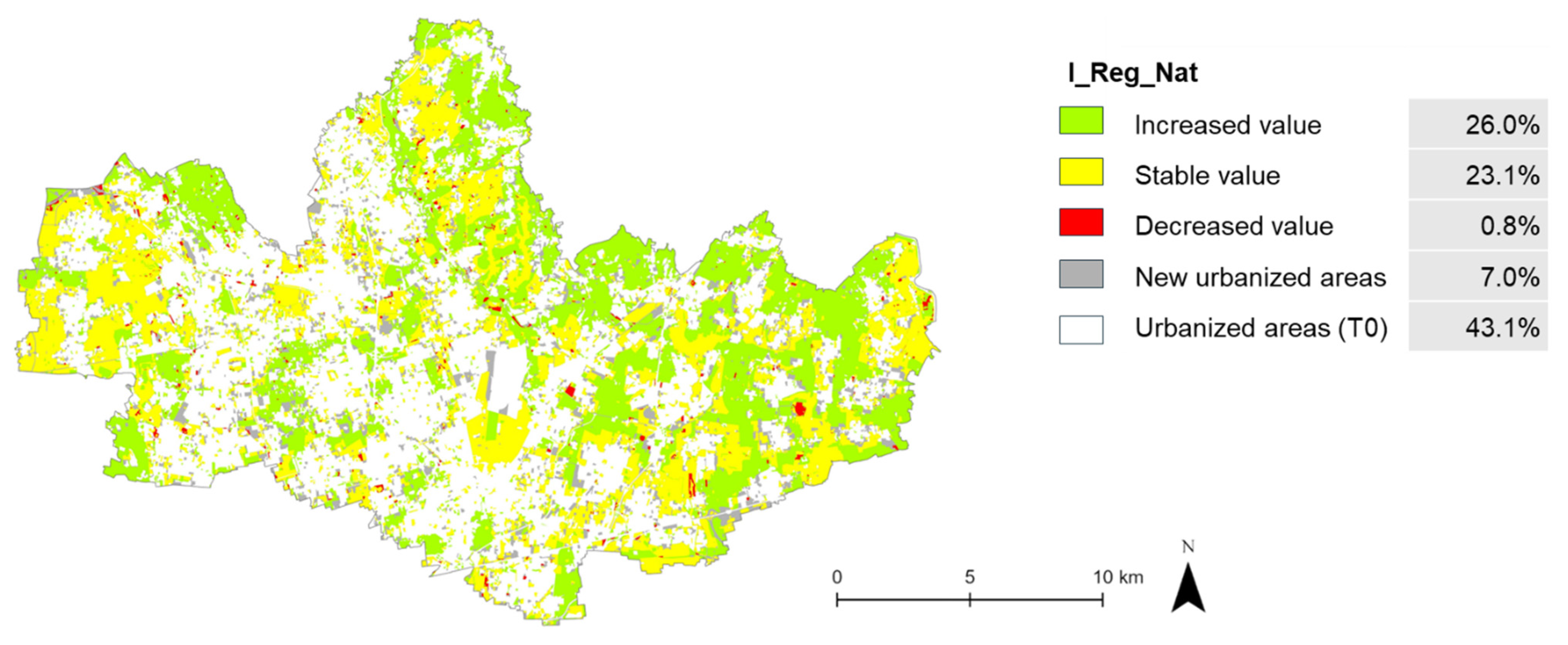
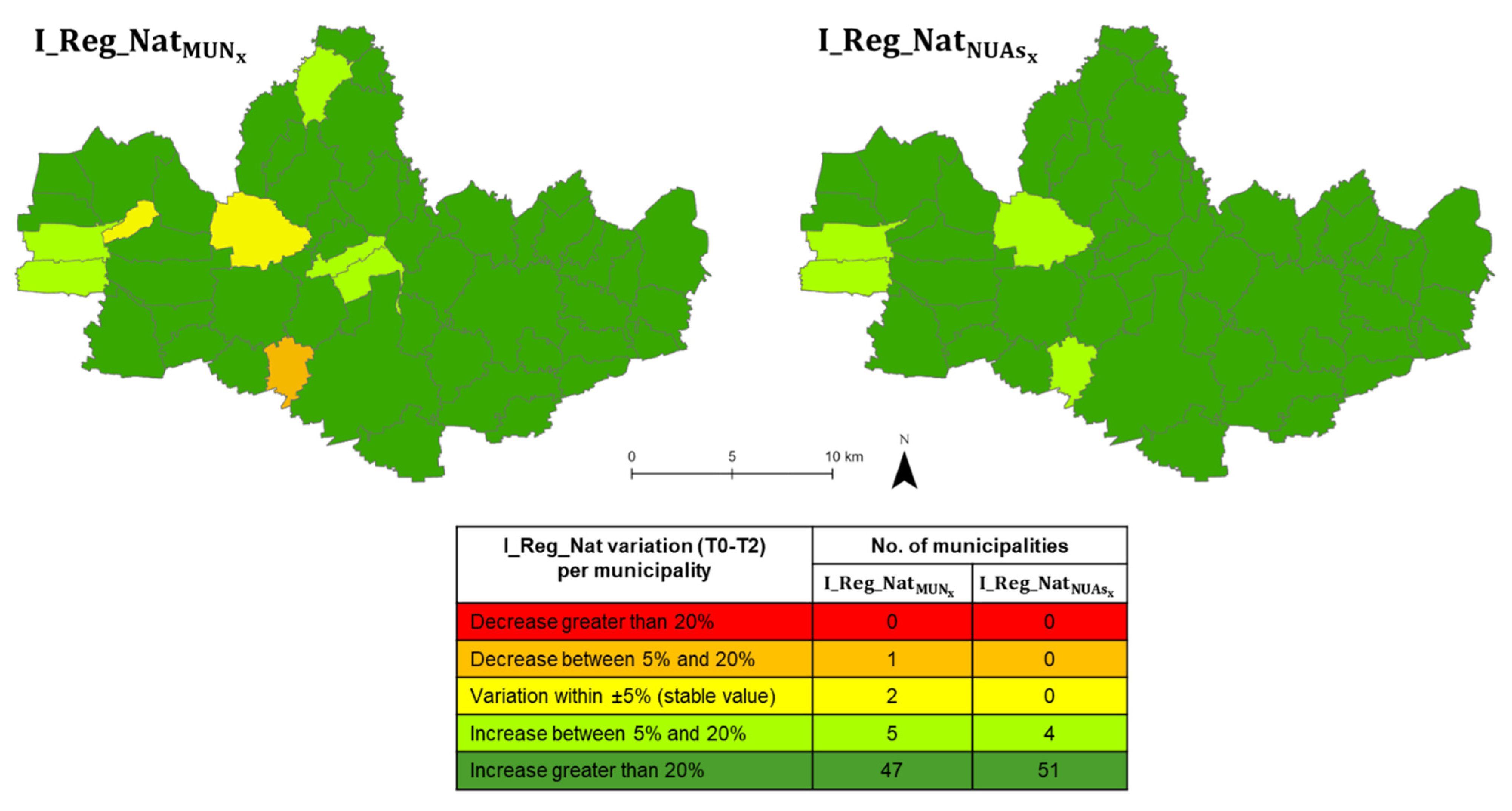
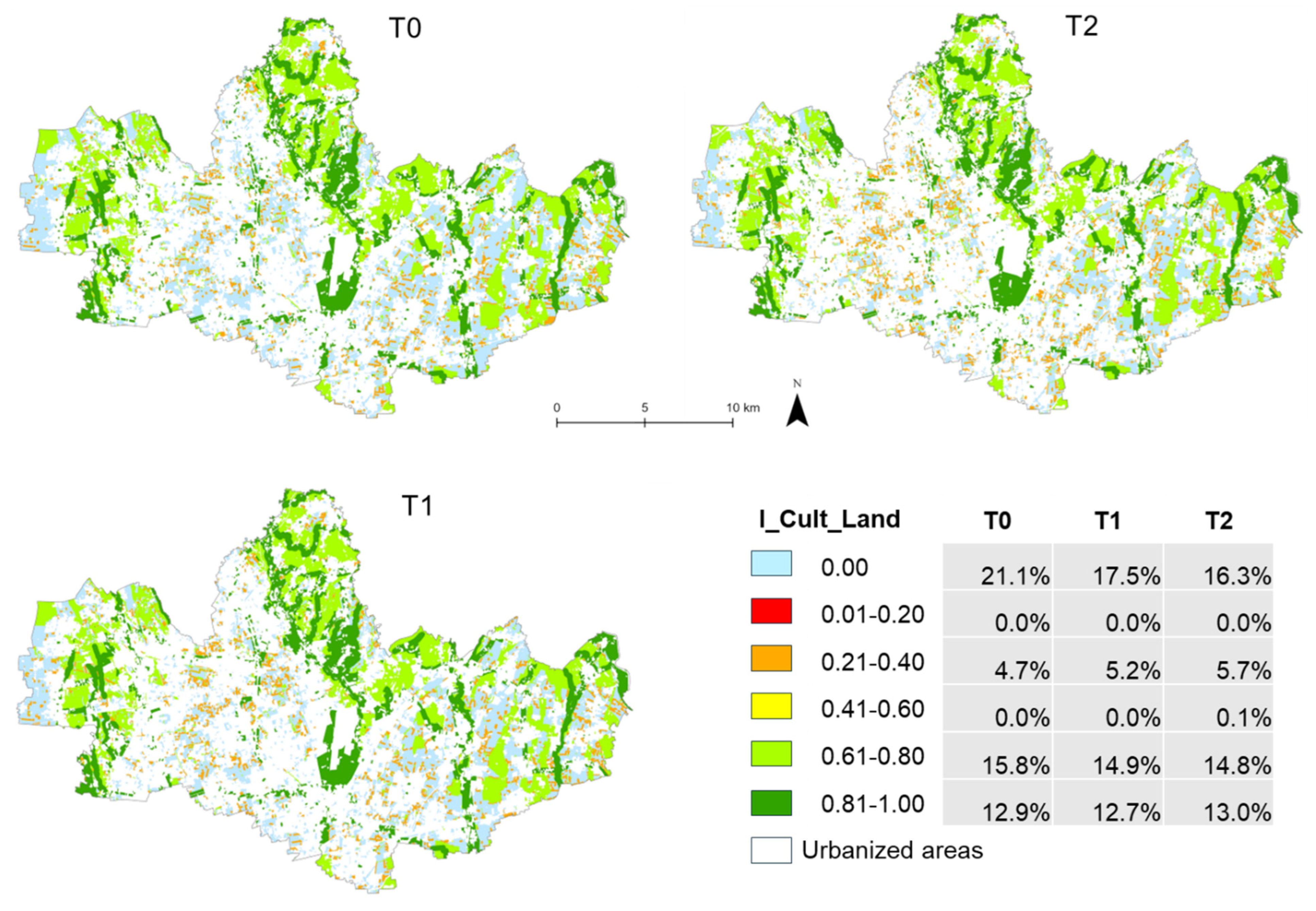

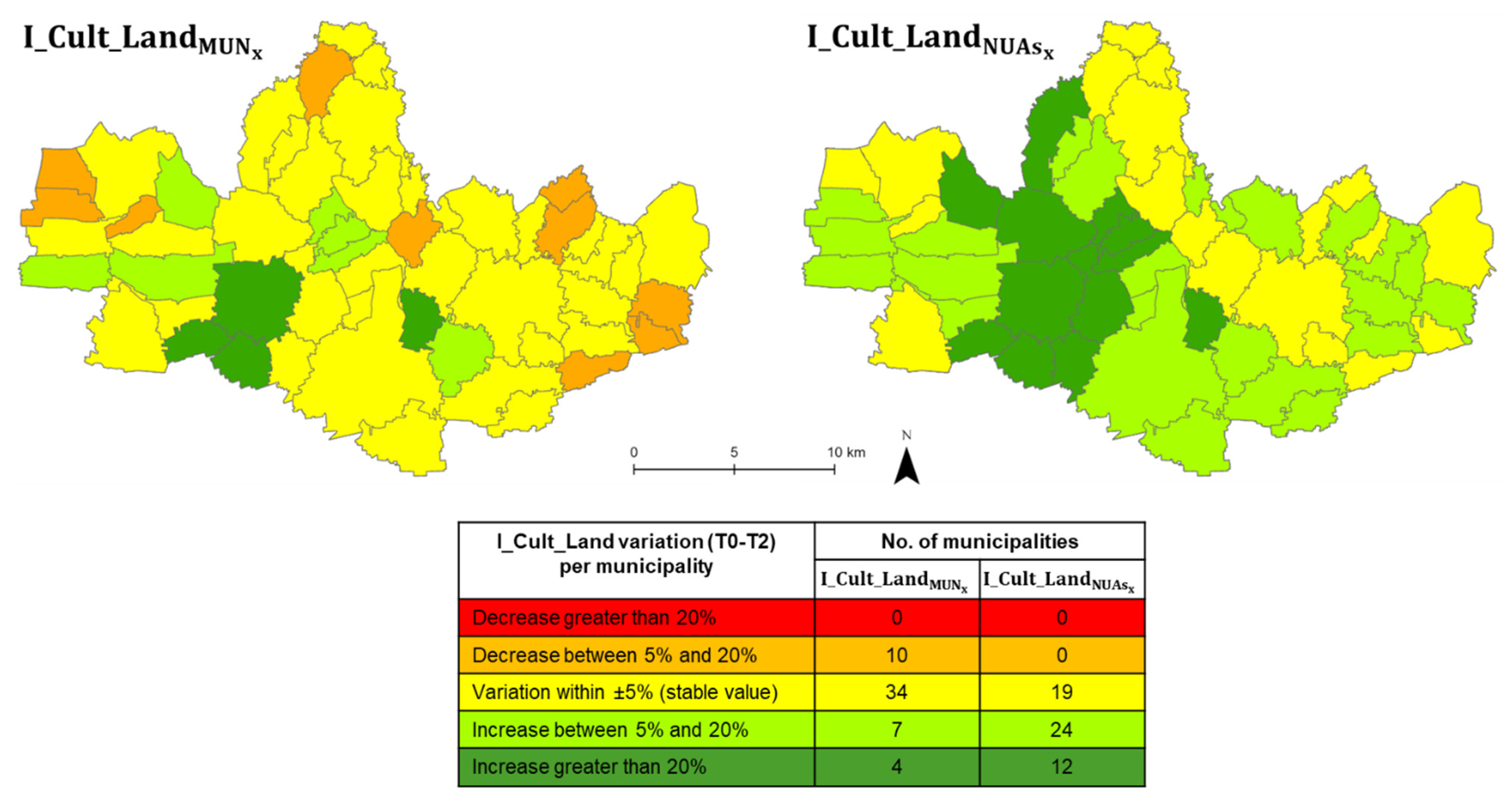

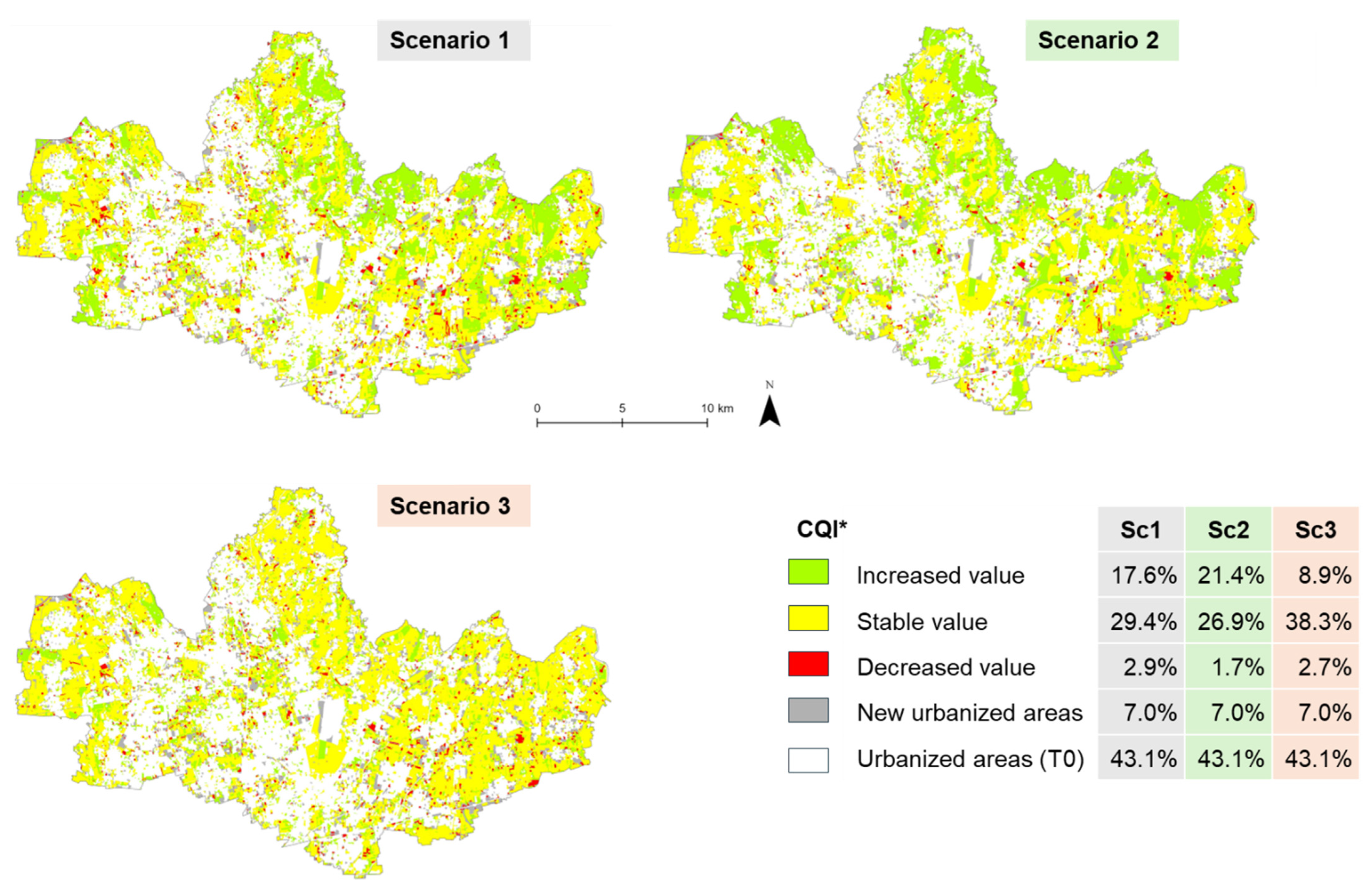
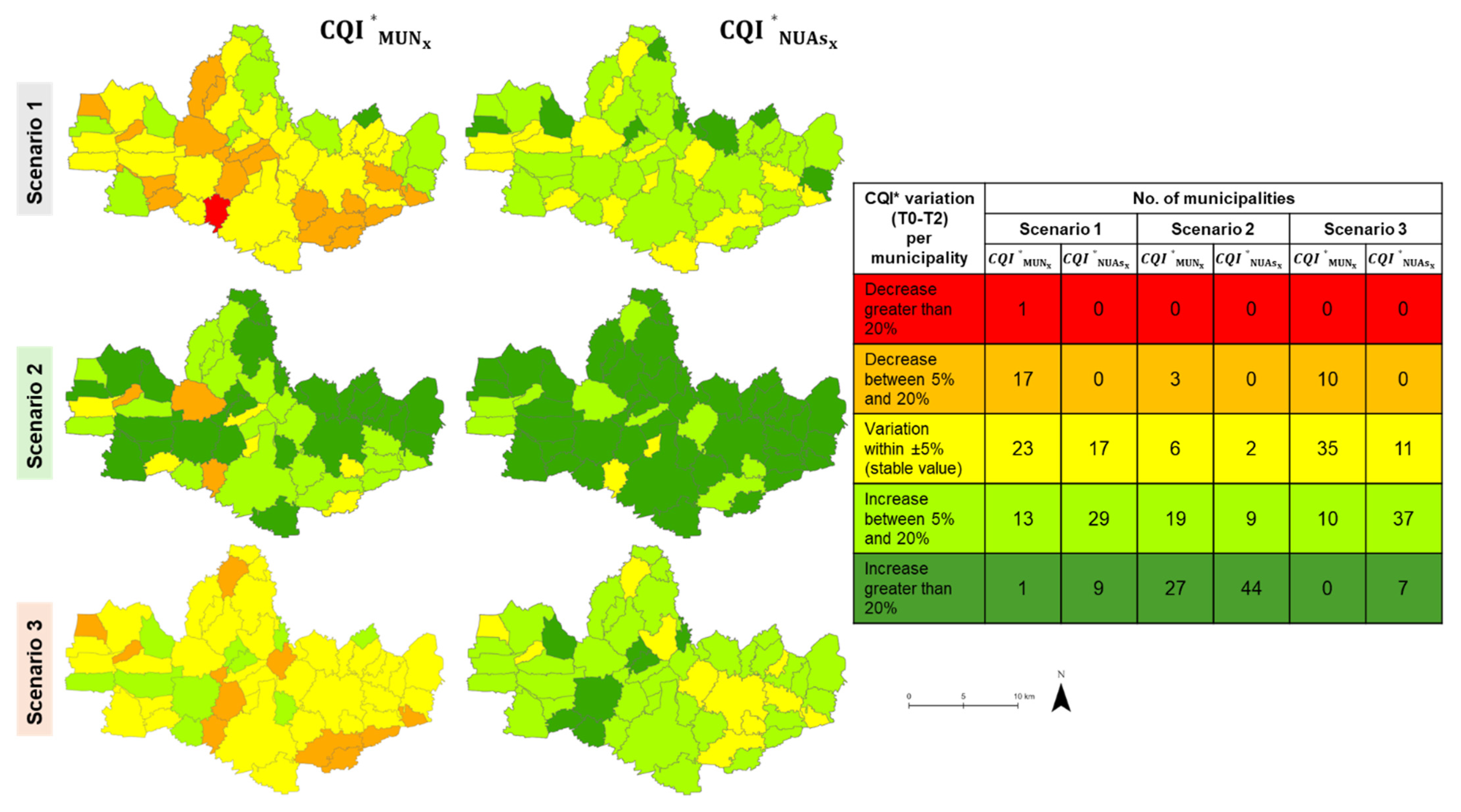
| Index | Databases |
|---|---|
| I_Prov_Agr | Agricultural land uses coming from DUSAF |
| I_Reg_Nat | Naturalistic value of soils, Parks and protected areas, Priority areas for biodiversity, Provincial ecological network, Regional ecological network, DUSAF |
| I_Cult_Land | Landscape restrictions, Historical and Scenic trails, Landscape Elements from Provincial Plans, DUSAF |
| Index | Scenario 1 | Scenario 2 | Scenario 3 |
|---|---|---|---|
| I_Prov_Agr | 0.33… | 0.25 | 0.25 |
| I_Reg_Nat | 0.33… | 0.50 | 0.25 |
| I_Cult_Land | 0.33… | 0.25 | 0.50 |
| Sum of the wights | 1.00 | 1.00 | 1.00 |
| NUAs | T0 | T1 | Δ T1-T0 | T2 | ΔT2-T1 | Δ T2-T0 | ||||||
|---|---|---|---|---|---|---|---|---|---|---|---|---|
| Sq.km | % | Sq.km | % | Sq.km | % | Sq.km | % | Sq.km | % | Sq.km | % | |
| Arable land | 157.0 | 38.8% | 119.1 | 29.4% | −37.9 | −24.1% | 120.9 | 29.8% | +1.8 | +1.5% | −36.1 | −23.0% |
| FNSNAs * | 47.1 | 11.6% | 64.7 | 16.0% | +17.6 | 37.4% | 59.4 | 14.7% | −5.3 | −8.2% | +12.3 | +26.1% |
| Other NUAs ** | 17.5 | 4.3% | 20.8 | 5.1% | +3.3 | 18.9% | 23.0 | 5.7% | +2.2 | +10.6% | +5.5 | +31.4% |
| Total NUAs | 221.6 | 54.7% | 204.6 | 50.5% | −17.0 | −7.7% | 203.3 | 50.2% | −1.3 | −0.6% | −18.3 | −8.3% |
| UAs *** | 183.5 | 45.3% | 200.5 | 49.5% | +17.0 | +9.3% | 201.8 | 49.8% | +1.3 | +0.6% | +18.3 | +10.0% |
| Study area | 405.1 | 100% | 405.1 | 100% | 405.1 | 100% | ||||||
| T0 | T2 | |||||||
|---|---|---|---|---|---|---|---|---|
| Arable Land | FNSNAs * | Other NUAs ** | Residential Areas | Industrial, Commercial and Sport Areas | Other UAs *** | Infrastructures | ||
| Arable land | 157.0 | 112.4 | 20.4 | 4.0 | 7.5 | 8.8 | 1.4 | 2.5 |
| FNSNAs * | 47.1 | 4.1 | 36.2 | 2.2 | 1.7 | 1.7 | 0.6 | 0.6 |
| Other NUAs ** | 17.5 | 0.8 | 1.0 | 12.2 | 1.1 | 1.8 | 0.3 | 0.3 |
| Residential areas | 113.8 | 2.1 | 0.6 | 1.8 | 102.9 | 3.8 | 0.4 | 2.2 |
| Industrial, commercial, and sport areas | 56.9 | 0.9 | 0.7 | 1.7 | 2.4 | 49.2 | 0.5 | 1.5 |
| Other UAs *** | 6.8 | 0.5 | 0.4 | 0.7 | 1.1 | 0.9 | 3.0 | 0.2 |
| Infrastructures | 6.0 | 0.0 | 0.0 | 0.3 | 0.0 | 0.0 | 0.0 | 5.7 |
| Total | 405.1 | 120.8 | 59.3 | 22.9 | 116.7 | 66.2 | 6.2 | 13.0 |
| Index | T0 | T1 | Δ T1-T0 | T2 | Δ T2-T1 | Δ T2-T0 | ||||
|---|---|---|---|---|---|---|---|---|---|---|
| I_Prov_Agr | I_Prov_AgrPROV | 0.340 | 0.295 | −0.045 | −13.2% | 0.284 | −0.011 | −3.7% | −0.056 | −16.5% |
| I_Prov_AgrNUAs | 0.624 | 0.588 | −0.036 | −5.8% | 0.569 | −0.019 | −3.2% | −0.055 | −8.8% | |
| I_Reg_Nat | I_Reg_NatPROV | 0.091 | 0.143 | +0.052 | +57.1% | 0.157 | 0.014 | +9.8% | 0.066 | +72.5% |
| I_Reg_NatNUAs | 0.167 | 0.284 | +0.117 | +70.1% | 0.315 | 0.031 | +10.9% | 0.148 | +88.6% | |
| I_Cult_Land | I_Cult_LandPROV | 0.274 | 0.267 | −0.007 | −2.6% | 0.272 | 0.005 | +1.9% | −0.002 | −0.7% |
| I_Cult_LandNUAs | 0.503 | 0.531 | +0.028 | +5.6% | 0.545 | 0.014 | +2.6% | 0.042 | +8.3% | |
| Scenario | Index | T0 | T1 | Δ T1-T0 | T2 | Δ T2-T1 | Δ T2-T0 | |||
|---|---|---|---|---|---|---|---|---|---|---|
| Scenario 1 | CQI*PROV | 0.233 | 0.233 | 0.000 | 0.0% | 0.235 | +0.003 | +1.1% | +0.003 | +1.1% |
| CQI*NUAs | 0.427 | 0.463 | +0.036 | +8.4% | 0.471 | +0.009 | +1.8% | +0.044 | +10.4% | |
| Scenario 2 | CQI*PROV | 0.152 | 0.182 | +0.030 | +19.7% | 0.191 | +0.009 | +5.1% | +0.039 | +25.9% |
| CQI*NUAs | 0.278 | 0.361 | +0.083 | +29.7% | 0.382 | +0.021 | +5.9% | +0.104 | +37.4% | |
| Scenario 3 | CQI*PROV | 0.257 | 0.254 | −0.004 | −1.4% | 0.258 | +0.004 | +1.6% | +0.001 | +0.1% |
| CQI*NUAs | 0.472 | 0.504 | +0.032 | +6.8% | 0.516 | +0.012 | +2.3% | +0.044 | +9.3% | |
Disclaimer/Publisher’s Note: The statements, opinions and data contained in all publications are solely those of the individual author(s) and contributor(s) and not of MDPI and/or the editor(s). MDPI and/or the editor(s) disclaim responsibility for any injury to people or property resulting from any ideas, methods, instructions or products referred to in the content. |
© 2025 by the authors. Licensee MDPI, Basel, Switzerland. This article is an open access article distributed under the terms and conditions of the Creative Commons Attribution (CC BY) license (https://creativecommons.org/licenses/by/4.0/).
Share and Cite
Senes, G.; Lussana, G.; Ferrario, P.S.; Rovelli, R.; Pedrazzoli, A.; Corsini, D.; Fumagalli, N. How Land-Take Impacts the Provision of Ecosystem Services—The Case of the Province of Monza and Brianza (Italy). Land 2025, 14, 1700. https://doi.org/10.3390/land14091700
Senes G, Lussana G, Ferrario PS, Rovelli R, Pedrazzoli A, Corsini D, Fumagalli N. How Land-Take Impacts the Provision of Ecosystem Services—The Case of the Province of Monza and Brianza (Italy). Land. 2025; 14(9):1700. https://doi.org/10.3390/land14091700
Chicago/Turabian StyleSenes, Giulio, Giulia Lussana, Paolo Stefano Ferrario, Roberto Rovelli, Ambra Pedrazzoli, Denise Corsini, and Natalia Fumagalli. 2025. "How Land-Take Impacts the Provision of Ecosystem Services—The Case of the Province of Monza and Brianza (Italy)" Land 14, no. 9: 1700. https://doi.org/10.3390/land14091700
APA StyleSenes, G., Lussana, G., Ferrario, P. S., Rovelli, R., Pedrazzoli, A., Corsini, D., & Fumagalli, N. (2025). How Land-Take Impacts the Provision of Ecosystem Services—The Case of the Province of Monza and Brianza (Italy). Land, 14(9), 1700. https://doi.org/10.3390/land14091700









